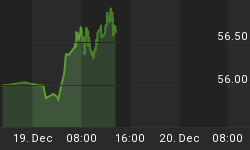Robert Prechter: "Charts tell the truth. Let's look at some charts."
During QE3, the latest round of the Fed's quantitative easing, the stock market rose. We all know that.
But did you also know that commodities fell?
That's right: QE3 had zero effect on commodities -- or maybe even a negative effect. In fact, an unbiased observer of the trend might conclude that the Fed drove commodity prices down.
That, of course, would be heresy to investors who believe that the Fed's actions have been inflating all financial markets.
What should you make of the fact that commodities have failed to respond to the massive, historic, unprecedented central-bank stimulus? We see it as a red flag.
What's more, you may be surprised to know that not one of the Fed's stimulus programs -- QE1, QE2 and QE3 -- pushed up commodity prices.
As Robert Prechter, the president of Elliott Wave International, wrote in his November 2013 Elliott Wave Theorist, "Charts tell the truth. Let's look at some charts." These four charts and analysis that he published in May, July, and November 2013 tell the story:
(Robert Prechter, July 2013 Elliott Wave Theorist)
The CRB index of commodities has been losing ground for more than two years, as shown in Figure 3. Notice the four short arrows on the chart. Based on their positions, you might think they would mark the timing of accurate sell signals generated by a secret indicator. But there's no secret indicator. These happen to be the times at which the Fed launched its inflationary QE programs!
Investors almost universally take news at face value rather than paradoxically as they should. So they believed the Fed's QE actions would be bullish for commodities. But -- ironically yet naturally -- every launch of a new QE program provided an opportunity to sell commodities near a high.
The first time the Fed bought a slew of new assets (QE0) was in 2008, and commodities went straight down during the entire buying spree.
QE1 (see below) was just a swapping of assets, not new buying, so it wasn't inflationary; ironically, commodities rose during this time.
Commodities rose a little bit after the inflationary QE2 started but ultimately went lower. Since QE3 and QE4 -- the two most aggressive programs of inflating the Fed has ever initiated -- commodity prices have been trending lower as well.
Are commodities just late and poised to soar? I don't think so. Figure 4 shows a chart of the CRB index published in The Elliott Wave Theorist back in May 2011.
It shows a three-step, countertrend rally ... inside of a parallel trend channel ... at a [Fibonacci] 62% retracement ... thus giving three reasons to expect a peak at that time. [Indeed] the CRB index has trended moderately but persistently lower since then.
Prechter gave another update in his November 2013 Elliott Wave Theorist:
Commodities are in a bear market. Figure 1 proves that the Fed's feverish quantitative easing (QE) -- i.e. record fiat-money inflating -- is not driving overall prices of goods higher.

The bear market in commodities began two months before the Fed's massive asset-buying program began. Despite the Fed's inflating at a 33% rate annually for five straight years, commodities are still slipping lower.
Prechter's final point from the November 2013 Elliott Wave Theorist summarizes it best:
None of the believers in omnipotent monetary authorities and their pledges to inflate saw any of those changes coming. Meanwhile, we couldn't see how it could turn out any other way.
The largest inverted debt pyramid in the history of the world is the reason that QE won't work. The future is already fully mortgaged.

15 Hand-Picked Charts to Help You See What's Coming in the Markets
Prepare for 2014 with a complimentary issue of Robert Prechter's Elliott Wave Theorist
Have you ever seen price charts that tell a story clearly? Prechter chose 15 charts to explain to his subscribers where the financial markets are headed in 2014. They cover markets like the S&P 500, NASDAQ, the Dow, commodities, gold, and mutual funds. With this information, they are now prepared to be on the right side of the financial markets. You can be, too, because, in a rare opportunity, we can offer you a look at the whole issue -- FREE.
Prechter says that "charts tell the truth." Here is your chance to see what truths these charts are telling. If a picture is worth a thousand words, then this latest publication is like reading more than 15,000 words of his market analysis.
Get your FREE 10 page issue of Robert Prechter's Theorist now >>


















